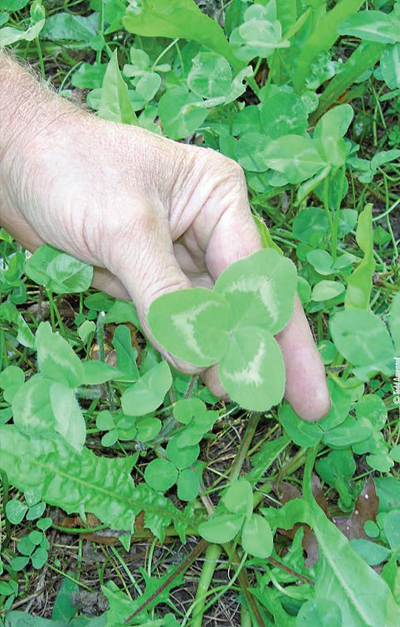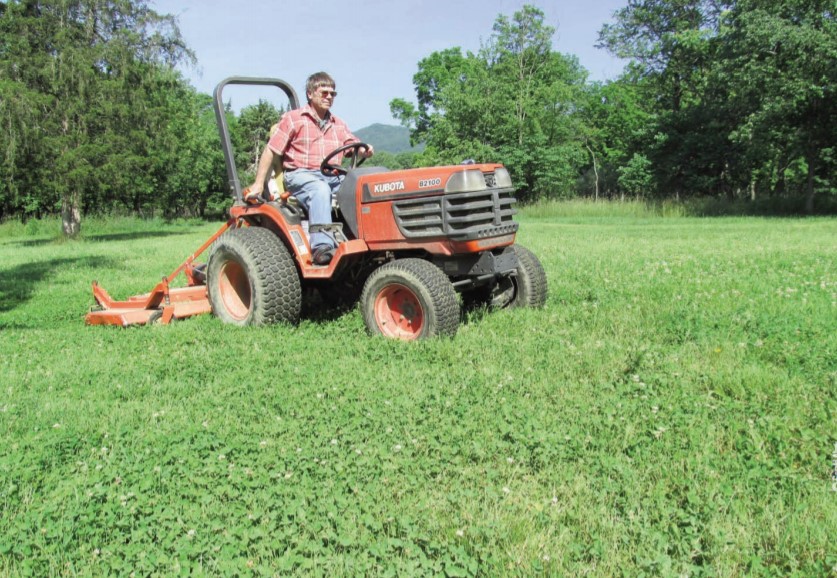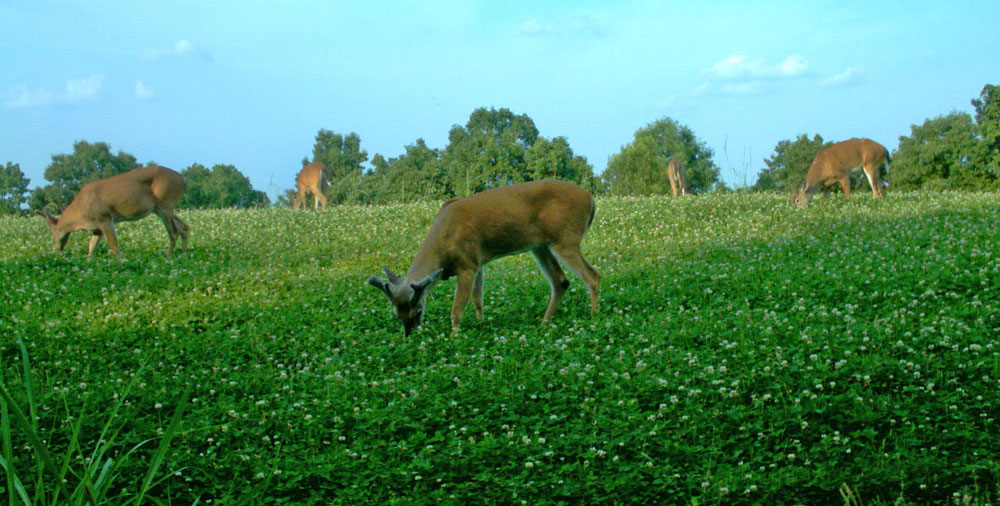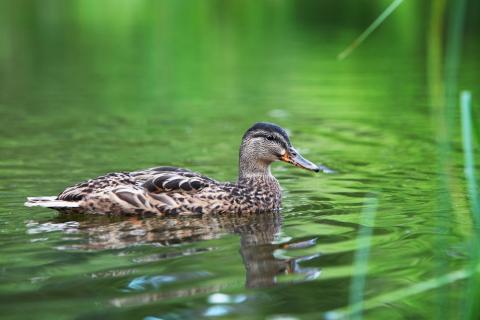Large Leaves, Big Bucks and Huge Success
Gerald Almy | Originally published in GameKeepers: Farming for Wildlife Magazine. To subscribe, click here.

other plants. It will do well with other perennials like
clovers, alfalfa or chicory, or when planted with a nurse
crop of wheat and oats like you see here.
I’ve always considered clover as my favorite food plot crop in spite of decades of trying just about every new seed offering that comes to market. The reasons why I turned to clover early on are fairly straightforward and easy to see. Many years ago when I first began growing food plots there wasn’t much else sold specifically for planting in a food plot for wildlife–during that time, clovers were the “go-to” deer planting.
I had just four acres of land, few tools and little money, clover was easy to grow, and fit my needs perfectly. I could use a hand sprayer to apply Roundup, crank up the garden tiller to work the soil and use a $10 plastic spreader to sow the seed and spread fertilizer. The deer ate it down hard, but couldn’t seem to kill it…like would have been the case if I had planted other crops like soybeans or ablab, especially on such a small scale. It was beautiful to look at, so my wife also liked it, and most importantly, it attracted deer to my small property.
As I upgraded my equipment, expanded my acreage and began putting in other food plot cultivars, clover, particularly white clover, still remained my favorite seed to plant. And along the journey, I learned a lot more about just why it’s such a fabulous crop to grow for the food-plotter and their wildlife. It has high protein levels, as a perennial it lasts for several years, is very economical and is reasonably tolerant of drought conditions. It’s also a strong competitor that holds its ground well against grasses and weeds. In the Deep South, clovers provide nutrition virtually 12 months a year. Where I live in northwestern Virginia they offer green forage 9-10 months, from March through November or December, depending on the severity of the winter. In the north clovers go dormant during the winter, but their cooler, humid growing season favors most varieties and the whitetails devour it there just like everywhere else.
Perhaps the most important trait is deer love the taste, but it’s difficult to kill from over-browsing. As they consume the forage, it simply regrows again and again. If you have a large deer herd and don’t want to fool with electric fences to keep animals out to protect forage growth, it is by far your best choice. Perennial clovers are often the cornerstone of many deer food plot programs. Not all clovers are created equally. Some grow better, attract better and persist better than others. I tried a number of the products offered by wildlife seed companies and had mixed results. Some were very good, some mediocre, and some poor. I also tried simply generic commodity seeds purchased at the local farm co-op. Those were generally poor to fair performers.
So it’s easy to see why I, like so many other managers, was excited to hear about a new clover for deer being offered by Mossy Oak BioLogic. I wanted to experiment and see how it performed for me. My first plantings were during late summer-early fall of 2014 when I put 8 pounds (1 acre) in the ground. The results were outstanding.
It’s called Non-Typical Clover, but the seed bag ingredients list one clover only, “Critical Mass.” The minute I saw that name, combined with the selling name of the product, a chill went up my spine–almost like it was made especially for me - I love non-typical deer and I always like unusual things, and a non-typical bucks are definitely that. Secondly, “critical mass” struck a chord immediately as well. Some hunters like lots of points. Others like a wide, sweeping spread on a rack or long main beams. For me, no characteristic of a rack “stokes my fires” more than mass. It just looks awesome, and it almost always indicates an old deer, which is more important to me than anything else about an animal—including score.

available from BioLogic. However, when compared to other
large-leaved whites, it is easier to establish, produces more
forage, stays palatable for longer and is quicker to recover
from stress.
Put those two names together and I was prejudiced favorably towards the new clover already. I was also intrigued by the fact that it was strictly one type of seed. Most products are blends. The developers must have thought so highly of this single Critical Mass variety that they didn’t want to dilute it with any other types of clover.
Testing on my land has proved it to, in fact, be a top-level clover seed to plant for whitetails (and turkeys). I’m not an expert enough to say whether it is the best clover on the market, I’ll leave it to others to make that call, but I’ll say it definitely ranks right up with the very best products I’ve ever used.
It’s easy to see why that’s so. The clover is the product of years of research and development and was chosen above many other potential contenders. I asked Bobby Cole, President of Mossy Oak BioLogic, if Non-Typical was an intermediate or a large-leaved, ladino type clover. “It’s a true ladino,” he said. “And it’s ours exclusively.
We were attracted to the many great characteristics this clover has for wildlife. It is hands down the easiest to establish and latest to go to flower that we’ve ever seen.”
Both of these later aspects are important, but the slowness in flowering is particularly significant. This means the clover will produce much more green forage in spring when fawns are being born and bucks are growing antlers before it switches gears and devotes its energy to producing flowers and seeds to perpetuate the stand. You want the plant’s energy to go to antlers and herd health, not to producing flowers and seeds.
I planted several different sites with small plots to see how the clover would perform in the different soil types I have - some drier upland spots and some bottomland areas. All plots produced well. The clover came up quickly, grew aggressively, and produced large amounts of forage.
I planted some alone and some with cover crops of wheat and oats. Both types fared well. Non-Typical is high in protein, so I knew it was offering tremendous benefits to both, nursing does and antler-growing bucks. It also has a large leaf, so animals can fill their bellies with fewer bites and get more nutrition for a given period of feeding. Most importantly of all, the deer love its taste.
Todd Amenrud, Editor in Chief for this publication, has tested Non-Typical in northern Minnesota’s cold climate and told me it stayed green well into fall, tolerated the bitter cold winter weather just fine, and came back strong in the spring. The clover has proven durable to heavy feeding pressure from deer and has a life expectancy of 3-5 years or more.
Austin Delano, Head of Research and Development for Biologic, says, “One of the first observations the research team made in testing the Critical Mass variety of clover was the quick establishment and substantial initial growth. In addition to its aggressive growth, it produced a lot of forage. Non-Typical averaged right at three tons of forage per acre.”

That is a lot of food for just an acre and will support the nutritional needs of quite a few deer for a large part of the season. That’s particularly true when it’s complemented with other plantings like brassicas, cereal grains, and summer annuals like lablab and soybeans.
That brings up a vital point, as good as Non-Typical is; you don’t want to plant all your available food plot acreage with it. A well-rounded food plot program includes a variety of perennials such as clover, alfalfa, and chicory as well as annuals like cowpeas, soybeans, and lablab for summer, radishes, brassicas, turnips, and sugar beets, plus cereal grains like oats and wheat for fall and winter.
Cultivate
There may be other equally effective ways to create a thriving clover stand and get maximum forage production and deer utilization, but here are the steps I take in planting and caring for my perennial clover plots. If your results are anything like mine, you’ll be carving out a regular spot in your food plot layout for this new, fast-growing Non-Typical ladino clover.
Choose the Right Time
You can plant this ladino clover in spring or late summer/fall. I find weeds are almost always troublesome with spring plots so I like the late summer-fall period best for my area. Timing can vary from late February-May (or even early June for the far north) for a spring planting to August-October for a late summer/fall planting. Select the site. Any size plot from tiny to huge works for Non-Typical. Plant small narrow hunting plots near bedding cover or transition corridors or big destination nutrition plots in larger fields, but make sure the spot gets at least 6- 7 hours of sunlight daily. Do a soil test and apply fertilizer & lime. This is crucial for any food plot crop, but especially white clover. Add enough lime to bring the pH to 6.5 or higher and fertilizer as recommended. Little or no nitrogen is required, but both phosphorus and potassium are vital and boron may be needed. Prepare the site properly. Kill weeds and grasses with herbicide, disk or till as needed, kill weeds again, disk, smooth the bed, and then cultipack.

If you have an active native seed-bank or if you’re claiming new ground you may want to change the order of steps. Because weed seeds can lay dormant in the soil for hundreds of years, and by disturbing the soil we in essence “plant” those weed seeds, changing the order and the timing of the steps can dramatically help prevent unwanted competition.
Work your soil and prepare the seedbed well in advance of planting (3 to 5 weeks). It’s not necessary to kill the existing plants first unless they are tall or thick and difficult to turn under. The green plant residue will break down much faster than dried, burned-down plant matter thus helping to retain any banked nitrogen and moisture. Let the native seed-bank germinate and green-up after working the soil…NOW kill everything with Roundup. Then plant without working the soil again. This way you’ll prevent the accidental “planting” of more weed seeds from your native bank. The main point is to plant after herbicide burn-down, but without working the soil again.
Broadcast the Seed
If the seedbed has been firmed, apply your seed and pack again for good seed-to-soil contact. If it’s been dragged, simply spread the seed, and use the equipment at your disposal to achieve the proper planting depth (1/4 inch).
Care Control Weeds & Grasses with Selective Herbicides
Weeds and grasses can compete heavily with your Non-Typical clover for nutrients, sunlight, and water. A few weeds and grasses aren’t catastrophic, but if they start to encroach too strongly, knock them back with sprays such as Weed Reaper and other appropriate selective herbicides. “Mowing strategies” is another topic where there are many opinions. Mowing is more of an art than a science. When experiencing cooler times during the growing season, white clovers can be mowed often and aggressively. Small-leaved varieties tend to respond best to this more aggressive mowing. Since Non-Typical is a single variety of a large-leaved white, it is recommended to mow less often (three times during the growing season) and less aggressively. Mowing is another great way to keep weeds and grasses in check. If they start to grow a few inches higher than the clover, mow their tops off by cutting just above the clover. When the clover begins to flower, especially if weeds are also building up, cut it just above most of the clover leaves - the goal is to trim most of the blossoms off, all of the weed seed heads, but leave some of the clover leaves. Mowing reinvigorates clover stands and initiates regrowth of tender new leaves that deer will find more palatable. I like to cut in strips on different days so there are always a variety of phases of clover from mature, uncut stands to fresh regrowing strips at different stages. Fertilize again during summer or early fall. If your clover is thriving, this may not be necessary. But an extra shot of phosphorus and potash, plus boron, sulfur, and zinc, if needed, can stimulate stronger growth, improve cold-hardiness and enhance the clover’s taste to deer. I like to add this after a cutting, but when there’s enough moisture that the clover is not stressed. Also consider applying M.E.E.N. Green or Deer Trac, both fine products for boosting your clover plot’s output and taste appeal to deer. Kill grasses again if necessary. Sometimes by late August or September new grass species and weeds will assert themselves or those killed in spring may come back. An application of appropriate herbicide at this time can knock back the competition and put your plot in great shape for the following spring. The best defense against weeds is a healthy clover stand.































